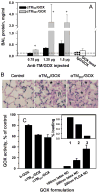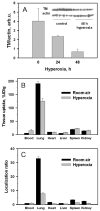Factors modulating the delivery and effect of enzymatic cargo conjugated with antibodies targeted to the pulmonary endothelium
- PMID: 17270308
- PMCID: PMC1855632
- DOI: 10.1016/j.jconrel.2006.12.025
Factors modulating the delivery and effect of enzymatic cargo conjugated with antibodies targeted to the pulmonary endothelium
Abstract
Vascular drug targeting may improve therapies, yet a thorough understanding of the factors that regulate effects of drugs directed to the endothelium is needed to translate this approach into the clinical domain. To define factors modulating the efficacy and effects of endothelial targeting, we used a model enzyme (glucose oxidase, GOX) coupled with monoclonal antibodies (anti-TM(34) or anti-TM(201)) to distinct epitopes of thrombomodulin, a surface determinant enriched in the pulmonary endothelium. GOX delivery results in conversion of glucose and oxygen into H(2)O(2) leading to lung damage, a clear physiologic endpoint. Results of in vivo studies in mice showed that the efficiency of cargo delivery and its effect are influenced by a number of factors including: 1) The level of pulmonary uptake of the targeting antibody (anti-TM(201) was more efficient than anti-TM(34)); 2) The amount of an active drug delivered to the target; 3) The amount of target antigen on the endothelium (animals with suppressed TM levels showed less targeting); and, 4) The substrate availability for the enzyme cargo in the target tissue (hyperoxia augmented GOX-induced injury). Therefore, both activities of the conjugates and biological factors control targeting and effects of enzymatic cargo. Understanding the nature of such "modulating biological factors" will hopefully allow optimization and ultimately applications of drug targeting for "individualized" pharmacotherapy.
Figures






References
-
- Muzykantov VR. Biomedical aspects of targeted delivery of drugs to pulmonary endothelium. Expert Opin Drug Deliv. 2005;2:909–926. - PubMed
-
- Everts M, Kok RJ, Asgeirsdottir SA, Melgert BN, Moolenaar TJ, Koning GA, van Luyn MJ, Meijer DK, Molema G. Selective intracellular delivery of dexamethasone into activated endothelial cells using an E-selectin-directed immunoconjugate. J Immunol. 2002;168:883–889. - PubMed
-
- Li S, Tan Y, Viroonchatapan E, Pitt BR, Huang L. Targeted gene delivery to pulmonary endothelium by anti-PECAM antibody. Am J Physiol Lung Cell Mol Physiol. 2000;278:L504–511. - PubMed
-
- Davda J, Labhasetwar V. Characterization of nanoparticle uptake by endothelial cells. Int J Pharm. 2002;233:51–59. - PubMed
-
- Mennesson E, Erbacher P, Kuzak M, Kieda C, Midoux P, Pichon C. DNA/cationic polymer complex attachment on a human vascular endothelial cell monolayer exposed to a steady laminar flow. J Control Release. 2006;114:389–397. - PubMed
Publication types
MeSH terms
Substances
Grants and funding
LinkOut - more resources
Full Text Sources
Other Literature Sources

